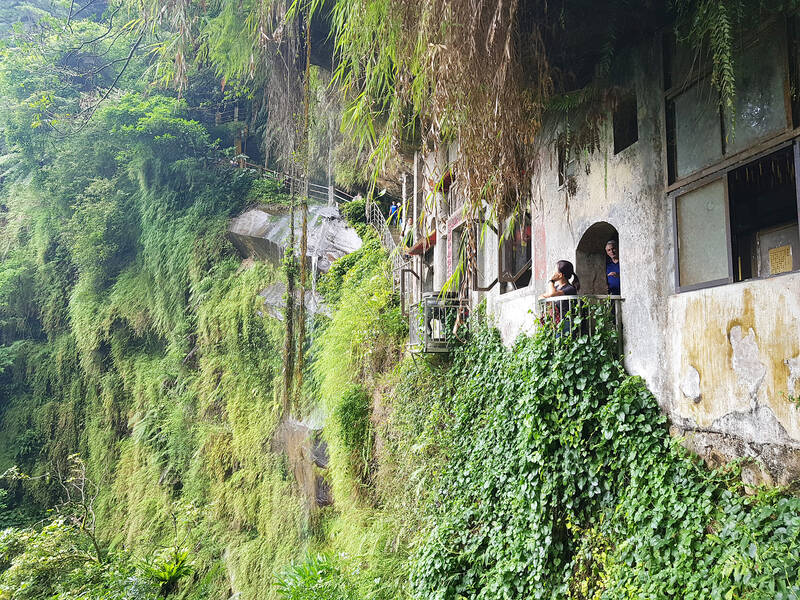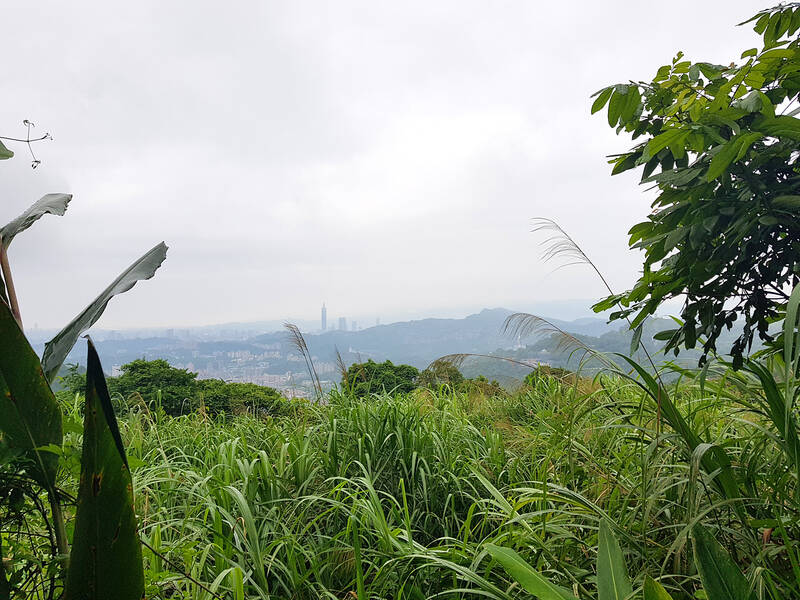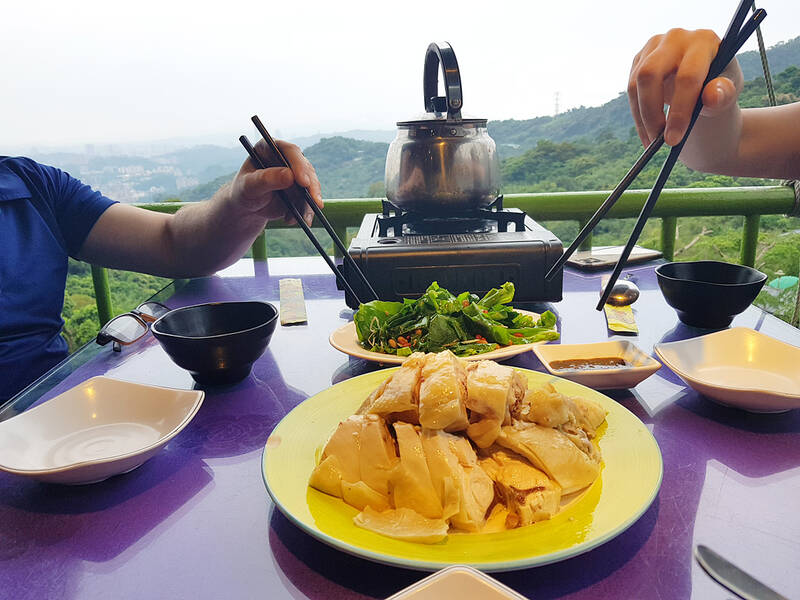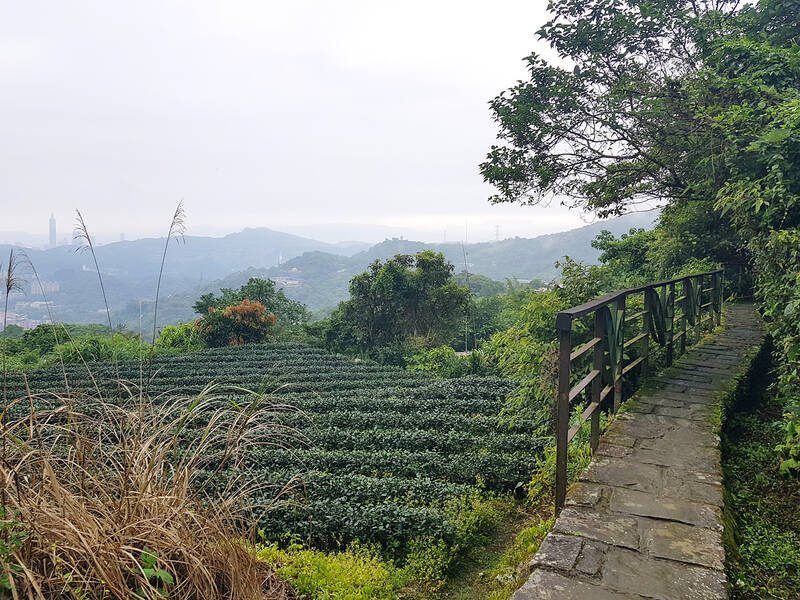A while back, I came up with a ratio to determine whether it’s worthwhile to visit a particular location, what I call the transit-to-travel ratio. It’s simple: at a minimum, only one-tenth of the time should be spent in transit — car, bus, plane, train.
A 20-minute MRT ride to Taipei’s Elephant Mountain, for example, and then a four-hour hike on the Taipei Grand Trail, counts as “making the ratio.” A High Speed Rail trip down to Kaohsiung and back and then several hours driving to and from the base of Jade Mountain to hike for one day is the kind of boots-on-the-ground journey that I would prefer to avoid. Dollars and environmental footprint aside, the real estate traveled isn’t worth the transit.
Taipei benefits from many transit-to-travel jaunts. On a Saturday last month, I take a 15-minute MRT to the Sindian station in New Taipei City and then a 10-minute taxi ride (20 minutes by the Green 12 bus) brings our party of three to a back-country road five minutes from the trailhead, for a three-hour hike on Erlong Mountain (二龍山). Perfect. And yet, there were complications even before we stepped onto the trailhead.

Photo: Noah Buchan, Taipei Times
Dogs are always a concern in rural areas — either because they are wild or trained to attack strangers. The dog warnings painted every few meters on the road leading up to the trailhead did not bode well. Confronting a dog on this treacherously slippery surface, everyone agreed, wasn’t a fortuitous way to begin a hike. Sure enough, as we approach the trailhead, a howling dog runs aggressively towards us, followed by a woman who has just emerged from a small temple screaming at it to heel.
“You can’t climb the mountain,” she says as she catches the dog — and her breath. “It’s far too slippery.”
Behind her, a second, taller woman, nods her head vigorously in assent. As the positive transit-to-travel ratio begins to fade, our threesome huddle to determine our next step. I venture over to the trailhead, a barely visible path of uneven mossy rock through dense foliage. It doesn’t look promising.

Photo: Noah Buchan, Taipei Times
As I return, one of our group — the kind that will by default do the opposite of what good sense might dictate if someone is dictating to him some good sense — says that we don’t need to listen. We’re come here to climb, goddammit, so let’s climb.
Sensing our doubt, the woman points to the feet of the third member of our group: “you aren’t wearing proper shoes.”
She then reveals her coup de grace: “A man recently died while climbing the mountain in these conditions,” she says. “A 26-year-old engineer.”

Photo: Noah Buchan, Taipei Times
As the temple ladies linger, the decision on how to proceed is left up to the wearer of improper shoes. Maybe the shoe gambit didn’t work, but clearly the bit about the engineer (which I later confirmed), was enough to seal the deal. We wouldn’t be hiking that mountain today.
Somewhat despondent, we prepare to slide back down the road from which we came, when a third person from the temple suggests a hike through Ejiaoge Mountain (鵝角格山), a trek that will bring us to the Maokong Gondola. So that’s what we do.
WATERFALLS AND SHRINES

Photo: Noah Buchan, Taipei Times
First we have to get there. A bus from a stop a few minutes away from where we stand will take us less than 10 minutes to get to our destination, a large Buddhist statue at the entrance of Yinhe Road (銀河路). However, after waiting for 30 minutes we give up and walk the 40 minutes it takes to get there on the moderately busy Beiyi Road (北宜路).
From there, Yinhe Road brings us up to Fude Temple (福德宮), which has bathrooms and a map of the entire hike. Another 100m up the road is the trailhead on the right and we are immediately plunged into dense jungle along a stone walkway. It takes about 20 minutes up the moderately steep stairs to reach Yinhe Cave and Waterfall (銀河洞瀑布).
It’s worth lingering here to explore the cave, which has been turned into a temple, complete with shrine and deities scattered in crevices throughout the small complex of rooms. There are plenty of windows to frame the scenic valley below. Although it had been raining the previous few days, the waterfall was a trickle — though it didn’t stop plenty of visitors from snapping pictures of it.

Photo: Noah Buchan, Taipei Times
After spending 20 minutes at the temple, we continue along the stone steps, which snake their way up Ejiaoge Mountain. Eventually the trail levels off, and leaves the dense foliage of the lower elevation behind. This part of the walk features creeks with plenty of fish, orchards, the occasional farm house and patches of bamboo. At one point, the pathway emerges to open views of a tea plantation in the foreground and Taipei 101 in the distance.
We soon reach the Zhanghu Trail (樟湖步道). Taking a right will lead us on to the Maokong Gondola, and it’s at this point that we realize that the entire trek really isn’t that long, less than an hour. So first, we turn left and wander along the Zhanghu Trail to the Dailaokang Trail (待老坑步道) about 15 minutes away and on to the outdoor performance grounds of famed drumming troupe, U-Theater and the bamboo grove where it is located.
With the trails well-marked by signs in English and Chinese, it is easy just to wander around and not get lost, and after doing so for an hour, we head back to the turnoff and walk the 20 minutes it takes to get to the crowded streets and tea houses surrounding the Maokong Gondola.
MAOKONG AND LUNCH
Fourth Brother (貓空四哥的店) is a 10-minute walk beyond the gondola and is well-known for its spectacular views, teas and Taiwanese cuisine, especially its tea oil noodles.
We arrive at 2:30pm after the lunch rush and are immediately whisked to the restaurant’s top floor, which has unobstructed views of the Maokong Gondola and eastern Taipei with the exclamation mark of Taipei 101 in the center.
Our party of three orders the tea oil noodles (NT$150), mountain chicken with skin (NT$460), stir-fried birds nest fern (NT$200) and shrimp fried rice (NT$250). I’d recommend everything, but the tea oil noodles in savory broth and succulent chicken served with a spicy and sweet sauce is worthy of the jaunt up the mountain.
We also ordered high mountain Jin Xuan tea (NT$350), a green tea grown locally, which arrives at the table in a sealed bag just after the small gas stove that will heat the pot of water. Soon, the rest of the implements needed to make tea in the traditional Taiwanese manner arrive, leaving very little room for the many dishes we ordered. In any event, the bag the tea leaves come in is enough for 20 pours, and one of our party was delighted to bundle it up and bring it home.
Satiated, the postprandial period saw us skip the gondola ride down to the city (which takes about 45 minutes), and walk back the way we came, eventually arriving at the watchful gaze of the Buddhist statue on Yinhe Road. We then waited a few minutes for an Uber to take us the five minutes back to the Sindian MRT, happy in the knowledge that we’d made the ratio.
IF YOU GO
GETTING THERE
There are taxis outside the Sindian MRT Station. It takes about 10 minutes to get to Fude Temple and costs around NT$150. Green bus number 12 also takes you to the entrance of Yinhe Road; get off at Yinhedong (銀河洞). It’s a 15-minute walk up to Fude Temple.

Oct. 27 to Nov. 2 Over a breakfast of soymilk and fried dough costing less than NT$400, seven officials and engineers agreed on a NT$400 million plan — unaware that it would mark the beginning of Taiwan’s semiconductor empire. It was a cold February morning in 1974. Gathered at the unassuming shop were Economics minister Sun Yun-hsuan (孫運璿), director-general of Transportation and Communications Kao Yu-shu (高玉樹), Industrial Technology Research Institute (ITRI) president Wang Chao-chen (王兆振), Telecommunications Laboratories director Kang Pao-huang (康寶煌), Executive Yuan secretary-general Fei Hua (費驊), director-general of Telecommunications Fang Hsien-chi (方賢齊) and Radio Corporation of America (RCA) Laboratories director Pan
The consensus on the Chinese Nationalist Party (KMT) chair race is that Cheng Li-wun (鄭麗文) ran a populist, ideological back-to-basics campaign and soundly defeated former Taipei mayor Hau Lung-bin (郝龍斌), the candidate backed by the big institutional players. Cheng tapped into a wave of popular enthusiasm within the KMT, while the institutional players’ get-out-the-vote abilities fell flat, suggesting their power has weakened significantly. Yet, a closer look at the race paints a more complicated picture, raising questions about some analysts’ conclusions, including my own. TURNOUT Here is a surprising statistic: Turnout was 130,678, or 39.46 percent of the 331,145 eligible party

The classic warmth of a good old-fashioned izakaya beckons you in, all cozy nooks and dark wood finishes, as tables order a third round and waiters sling tapas-sized bites and assorted — sometimes unidentifiable — skewered meats. But there’s a romantic hush about this Ximending (西門町) hotspot, with cocktails savored, plating elegant and never rushed and daters and diners lit by candlelight and chandelier. Each chair is mismatched and the assorted tables appear to be the fanciest picks from a nearby flea market. A naked sewing mannequin stands in a dimly lit corner, adorned with antique mirrors and draped foliage

President William Lai (賴清德) has championed Taiwan as an “AI Island” — an artificial intelligence (AI) hub powering the global tech economy. But without major shifts in talent, funding and strategic direction, this vision risks becoming a static fortress: indispensable, yet immobile and vulnerable. It’s time to reframe Taiwan’s ambition. Time to move from a resource-rich AI island to an AI Armada. Why change metaphors? Because choosing the right metaphor shapes both understanding and strategy. The “AI Island” frames our national ambition as a static fortress that, while valuable, is still vulnerable and reactive. Shifting our metaphor to an “AI Armada”